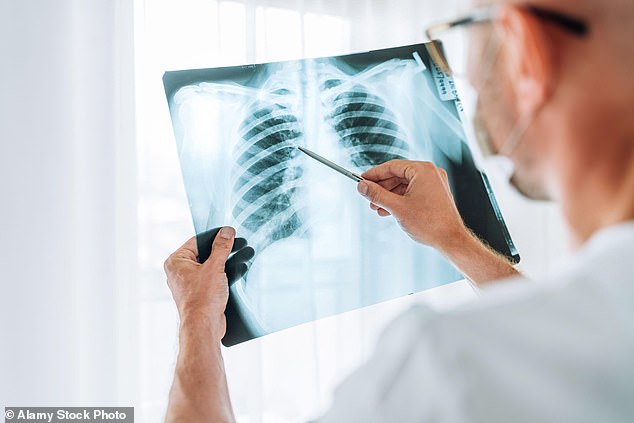If I have arthritis, should I stop working? Ask your GP DR MARTIN SCURR
I have had arthritis in my left thumb for five years — and now I have similar pain in my right thumb and along the outside of my wrist. Would steroid injections help? I am a self-employed tiler and do not want to retire at 62.
Frank Martin, Glasgow.
I can see why this would be a concern for a professional like you. I suspect the pain is caused by osteoarthritis — joint damage from the wearing down of cartilage.
The thumb has two bones (‘phalanges’) and is connected to the hand by the metacarpophalangeal joint. This forms part of the ball of your thumb and gives your thumb dexterity.
The next bone, the metacarpal, is attached to the wrist via another joint, the carpometacarpal joint.
If you experience pain at the base of your thumb, one or both joints are affected. If you have been experiencing this for months, chances are you have osteoarthritis.
I have had arthritis in my left thumb for five years — and now I have similar pain in my right thumb and along the outside of my wrist. Would steroid injections help? (stock)
In addition to pain, the joint is usually swollen and the area is tender due to inflammation. Your grip may be weaker and you may notice a cracking sensation (‘crepitation’) when moving your thumb. Patients with osteoarthritis of the base of the thumb are often offered steroid injections, but unfortunately, research has shown that these are no more effective than a dummy injection.
However, topical treatment with a nonsteroidal anti-inflammatory drug (NSAID) containing ibuprofen or diclofenac has been shown to help.
You mention in your longer letter that you can’t take NSAIDs because of the risk of ulcers. However, a study of over 900 patients using NSAID gel for knee arthritis showed that it was safe in the long term — even in those at high risk for NSAID side effects.
I would recommend going to your GP to confirm this diagnosis, then try diclofenac gel, twice a day, available over the counter.
If the pain persists, a last resort is surgery to replace these damaged joints. However, if you have chosen this route, a specialist would also advise you to stop working. I know this is not what you want to hear, but it may be time to take early retirement.
My Apple Watch shows my VO2 max, 18.7, is below average. I exercise 55 minutes daily, but I can’t seem to increase my VO2 max. What else can I do? I am a 73 year old female taking felodipine and simvastatin.
Janet Sawyer, Sutton Coldfield.
Nowadays, many people use technology to monitor their health, so I can understand your question.
First, let me explain VO2 max. This is a measurement of the amount of oxygen your muscles use during exercise.
It’s a measure of your cardiovascular fitness: the higher the number, the more efficiently your body uses oxygen and the better your fitness.

My Apple Watch says my VO2 max is below average at 18.7. I exercise 55 minutes a day but I can’t seem to increase my VO2 max. What else can I do? (stock)
It’s hard to get accurate readings unless you wear a mask that allows for accurate measurement of the amount of oxygen you inhale (and carbon dioxide you exhale) while exercising on a treadmill or static bike. Home testing devices are less accurate and calculate an estimated VO2 max.
A good measurement for your age range would be 20.2 to 24.4, while a good result would be 28.1.
Since you exercise regularly, the question arises: why is your VO2 max result so low?
I wonder about the cardiovascular aspect: the felodipine you are taking is for high blood pressure. Perhaps you should discuss the dosage with your GP.
I see you are also taking 40mg simvastatin, the maximum. This could have been prescribed because you had chest pain at some point.
To improve your VO2 max, I recommend that you work with a qualified personal trainer to guide you through an aerobic training program.
I would also advise you not to worry too much about these readings. Focus on how much better you will feel as you get fitter.
I think… The office doctor will see you now
Should large companies be encouraged to offer primary care to their employees?
Twice a week I am the practice doctor of an organization that has set up a medical facility at its workplace.
Here, employees can get immediate help with problems that require medical attention. They don’t have to wait for an appointment and diagnosis with their own GP (or, all too often, with a physician assistant or practice nurse). And they don’t have to leave the office.
Many of the problems I have encountered here have been minor, such as sports injuries, hay fever, eye infections, contraception and foreign travel advice. However, sometimes I have seen more serious problems, such as early detection of cancer.
While employees enjoy access and continuity of care from a clinician they get to know, and the reassurance of having an expert in the office, the employer sees less absenteeism. Employees also value the benefit of having the service as part of their employment, and the NHS is relieved of some of the burdens.
A stitch in time…
